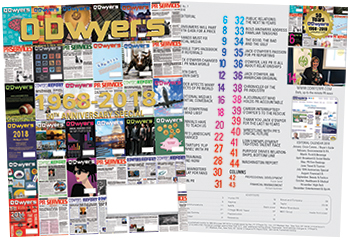 Harold Burson |
Few public relations executives would disagree that digital technology, over the past quarter century, has impacted their work more than any technical development since Gutenberg invented the printing press in the 15th Century.
Most would also agree that the use of digital technology is still a work in progress. It has upgraded the research output upon which public programs are based. But it has also created unintended consequences that have the potential to have major adverse effects on society on a global scale, some as serious as creating a wartime environment and playing a major role in the conduct of war itself. It has undermined personal and institutional privacy and put at risk such systems as electric power grids, aircraft control systems, transmission systems and automated production systems that serve both the private and public sectors.
|
|
There’s still some question on the function of digital technology in public relations. Certainly, it will not replace PR, a theme of many trade press articles when computers were first introduced. My view of digital places it in the continuum that began with the printing press and continued with the telegraph, the telephone, motion pictures, television, cable, the satellite and other gadgets that expedite the transmission of the printed or spoken word.
The great benefit of digital technology is that it has provided greater transparency, both personal and institutional, on which public relations can be effectively based. It’s economical and has global reach.
As I have stated on numerous occasions, one fault in the public relations process is that industry executives have worked diligently to produce programs that provided solutions to the wrong problem. The 2016 election demonstrated that by describing more precisely the attitude of individual voters and testing scenarios for the selection of candidates but also in the selection of products and services.
Undoubtedly, government entities will have a say regarding the protection of privileged and private information of individuals and institutions. But the decision is likely to be several years distant. Meanwhile, digital will continue to expand its influence on PR.
In the area of change, another major shift is likely to be that corporations will be more transparent in describing their actions to the public.
CEOs will give more attention to the public’s attitude toward their business. Mission statements and the like will be more than framed plaques hanging on the wall in the company’s lobby. A big change will be that the public will know much more about the corporation that’s responsible for the brand. Public relations and marketing will be conversing at the policy level.
Already, efforts are taking shape to demonstrate that corporations exist to serve the public as well as make a reasonable profit to pay a fair return to its shareholders. Don’t be surprised if profit sharing plans with employees come into vogue as a recognition of the average workman’s contribution to corporate success.
Another change we can look for is the effect of the increased female work force in the PR sector. Women started public relations careers in earnest with the turn of the century. It’s not unusual today to identify significant numbers of females with twenty or more years’ experience. My feeling is this will, in the next decade or two, be translated into a more caring and sharing corporation.
All in all, I’m bullish on public relations’ future. A problem that must be overcome is to provide job opportunities that create generalists. Specialists are important. But CEOs require experienced generalists and, today there are too few of them, male and female.
***
Harold Burson is co-founder of Burson-Marsteller.



 The NBA, which promotes legalized gambling 24/7, seems more than hypocritical for banning player for placing bets... Diocese of Brooklyn promises to issue press release the next time one of its priests is charged with sexual abuse... Truth Social aspires to be one of Donald Trump's iconic American brands, just like Trump University or Trump Steaks or Trump Ice Cubes.
The NBA, which promotes legalized gambling 24/7, seems more than hypocritical for banning player for placing bets... Diocese of Brooklyn promises to issue press release the next time one of its priests is charged with sexual abuse... Truth Social aspires to be one of Donald Trump's iconic American brands, just like Trump University or Trump Steaks or Trump Ice Cubes. Publicis Groupe CEO Arthur Sadoun puts competition on notice... Macy's throws in the towel as it appoints two directors nominated by its unwanted suitor... The Profile in Wimpery Award goes to the Ford Presidential Foundation for stiffing American hero and former Wyoming Congresswoman Liz Cheney.
Publicis Groupe CEO Arthur Sadoun puts competition on notice... Macy's throws in the towel as it appoints two directors nominated by its unwanted suitor... The Profile in Wimpery Award goes to the Ford Presidential Foundation for stiffing American hero and former Wyoming Congresswoman Liz Cheney. JPMorgan Chase chief Jamie Dimon's "letter to shareholders" is a must-read for PR people and others interested in fixing America and living up to its potential... Get ready for the PPE shortage when the next pandemic hits... Nixing Netanyahu. Gaza carnage turns US opinion against Israel's prime minister.
JPMorgan Chase chief Jamie Dimon's "letter to shareholders" is a must-read for PR people and others interested in fixing America and living up to its potential... Get ready for the PPE shortage when the next pandemic hits... Nixing Netanyahu. Gaza carnage turns US opinion against Israel's prime minister. Trump Media & Technology Group sees Elon Musk's X as an option for those who want the free expression promised by Truth Social but without Donald Trump, owner of 57.3 percent of TMTG... Chalk one up for "anti-woke warrior" governor Greg Abbott as University of Texas lays off 60 DEI-related staffers... Five percent of Americans see the US as its own worst enemy, according to Gallup.
Trump Media & Technology Group sees Elon Musk's X as an option for those who want the free expression promised by Truth Social but without Donald Trump, owner of 57.3 percent of TMTG... Chalk one up for "anti-woke warrior" governor Greg Abbott as University of Texas lays off 60 DEI-related staffers... Five percent of Americans see the US as its own worst enemy, according to Gallup. Nine of the Top 100 firms that participated in O'Dwyer's rankings last year apparently threw in the towel for the 2024 scorecard. Seven other firms also went AWOL.
Nine of the Top 100 firms that participated in O'Dwyer's rankings last year apparently threw in the towel for the 2024 scorecard. Seven other firms also went AWOL.


 Have a comment? Send it to
Have a comment? Send it to 
No comments have been submitted for this story yet.